So you decided to create a killer online course but now it doesn’t seem to be selling that well.
- So how do you sell your course passively?
- How do you market it without spending money on ads?
- And most importantly, how do you leverage social media to get a consistent, passive stream of customers going to your course landing page and buying your course without having to put in any additional effort?
If those are the questions that you’ve been thinking about I’ll answer all of them in this ultimate digital marketing guide for online courses:
Passive ways to promote your online course
Passive ways mean that once you put in the initial effort to create something that will bring you customers, you won’t have to do it again and again to bring more customers.
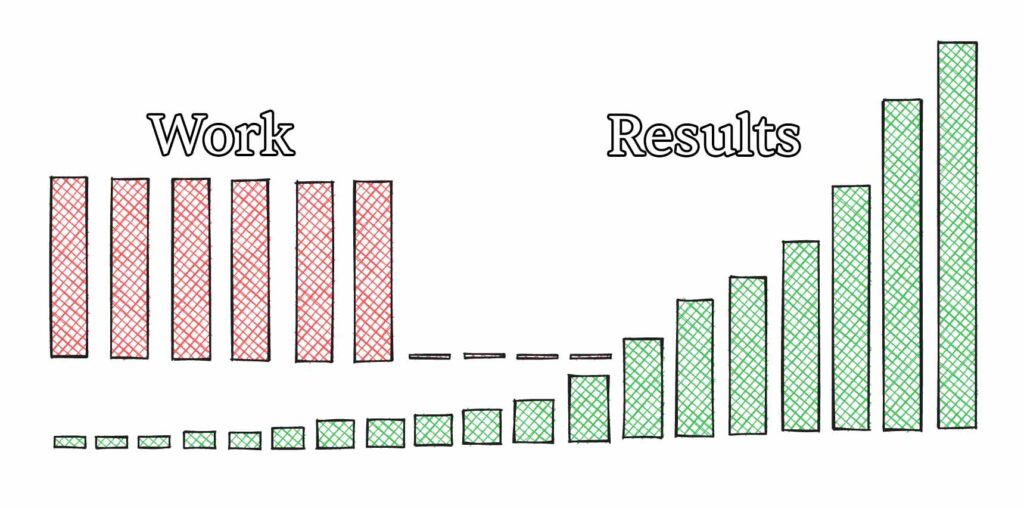
It will work for you in the background. Even while you sleep.
Here are the best ways to market your online course and get students to enrol passively:
1. Make YouTube videos about your course topic
One of the best places to promote your digital course is social media.
Social media gives you leverage. It multiplies the work you put in.
You can spend 3 days creating a YouTube and that video can be seen by millions of people.
Otherwise, it would take you forever to email or message a million people.
But why YouTube? Why not Instagram or TikTok?
First, YouTube pays creators that create content on their platform. So not only will you be able to organically promote your course but also get paid to do so.
While other social media platforms are a good alternative, the best part about YouTube is that it surfaces content no matter its age.
So your video where you promote your online course can be seen 1 month from now, 3 years from now or 10 years from now.
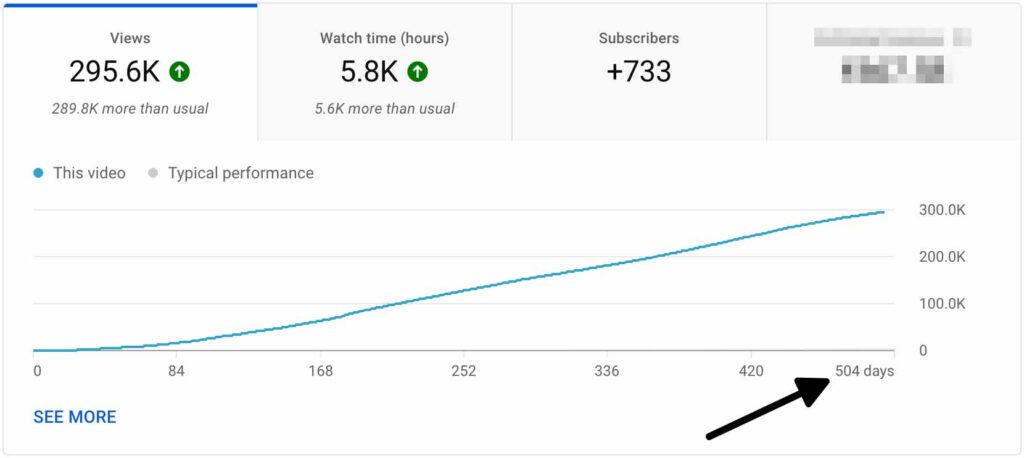
But how can you create a video that your potential course students will find interesting and useful long into the future?
A timeless video usually:
1. Helps solve a timeless problem.
A timeless problem is a problem that people struggled with 5 years in the past and that still persists today.
Such as how to have time for yourself as a mom, how to be more productive, how to learn more efficiently, how to make money online, how to exercise, how to eat healthier, etc.
2. Isn’t tied to current events.
For example, doesn’t mention any dates or recent events that will inevitably become irrelevant in the future.
3. Has a clickable thumbnail and title.
I.e. looks like a great package that people will want to click on now and in the future.
I recommend checking out my guides on how to create a thumbnail viewers can’t resist and how to write YouTube titles viewers can’t resist to learn more about how to package your video well.
4. Has high production quality.
High production quality can mean different things but usually, the most important thing for a video isn’t great video quality. It’s good audio quality.
I have a 30-minute course on Skillshare about how to make an amateur voice-over sound professional without expensive gear. If you want, you can take it for free with Skillshare’s 30-day free trial.
And if you think that you won’t be able to make a good YouTube video that transcends time I have a full flagship YouTube Video Course.
As a result of taking it, students will be able to make studio-quality YouTube videos at home in their bedroom without showing their faces and while saving hundreds of dollars on expensive studio gear.
For the record, this is the passive traffic that currently comes to my YouTube Video Course’s landing page every day:
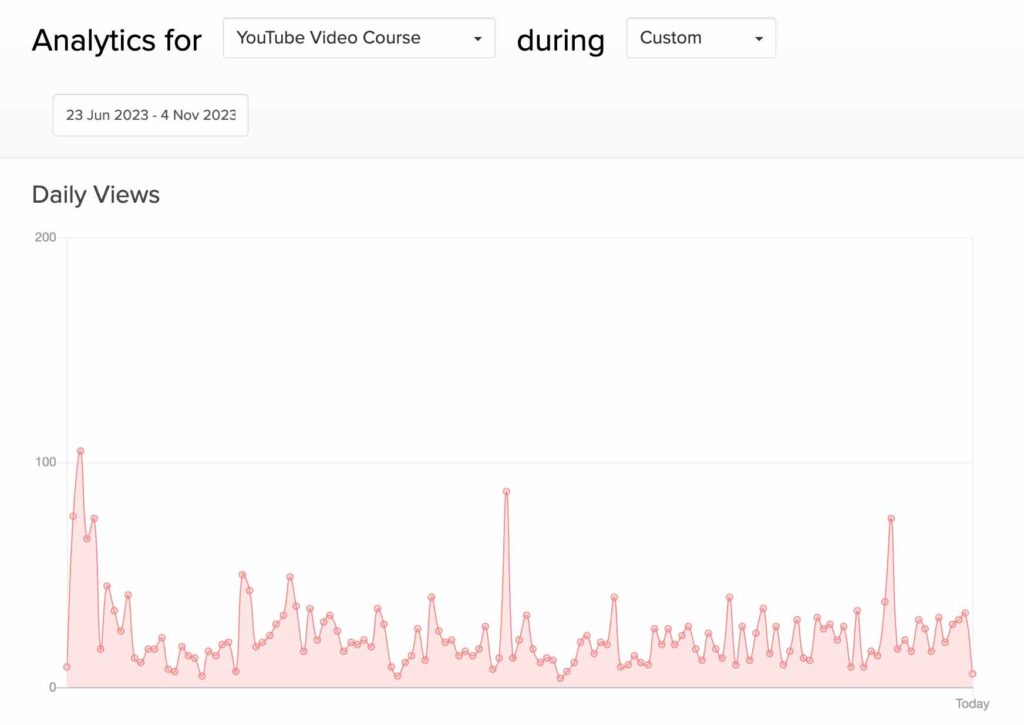
Now what kinds of videos should you make to get enrolments for your course?
The best videos that you can use to market your course are educational videos.
Make a video that helps your viewers solve a problem that’s closely related to a problem that you help solve in your course.
Alternatively, you can make videos that include the information from parts of your course for free and then offer your course as a full package that has all the information neatly packaged into a single place.
That’s what I do with my YouTube Video Course.
I create a video such as this one where I showcase some cool editing tricks for YouTube videos and then I mention my course if someone really wants to learn how to produce and edit videos even if they have 0 prior experience with it.
2. Post parts of your course on platforms like Skillshare and Udemy
Another great way to market your course passively is to publish a part of it on course platforms that already have an audience seeking out for online courses.
There are 2 best platforms for this – Udemy and Skillshare.
You can take a few chapters of your larger course, add an introduction for it as well as a conclusion where you mention that these lessons are a part of a bigger, flagship course.
Think of it as a mini-course that solves a smaller problem than your flagship course.
The best part is that if a course is good and actually helps someone achieve a transformation these platforms will push it out to students passively without you having to do anything.
As a bonus, you’ll also get paid for someone taking your “mini-course” which acts as a marketing vehicle for your bigger course.
If you think about it, you get paid to advertise your course. That’s insane.
I have a few courses on Skillshare and here’s how consistent the traffic looks:
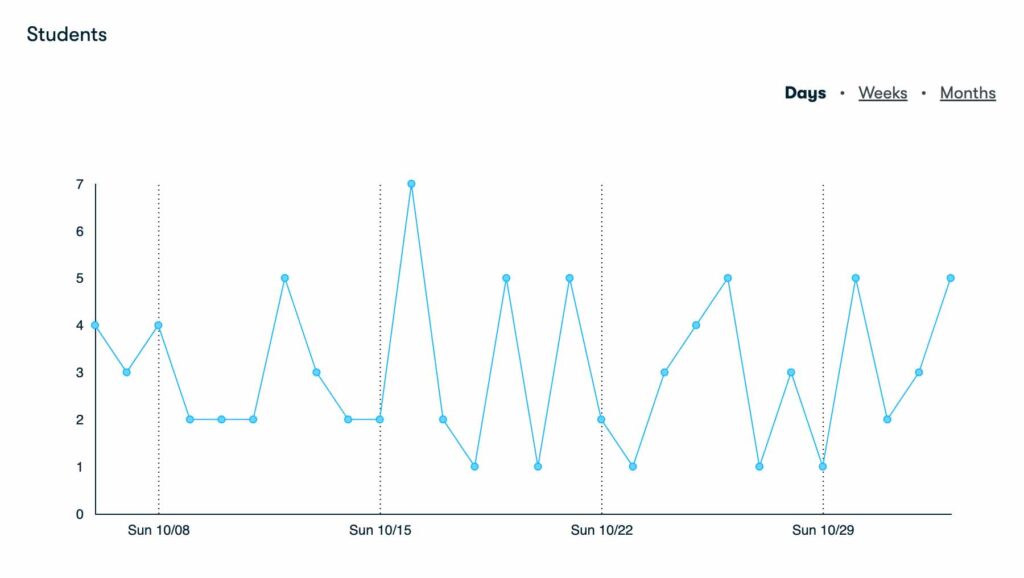
It jumps up and down from day to day but the overall trend is consistent.
3. Create a blog post about your course topic
The most passive of all the course promotion methods is creating a blog to promote your course.
Even if it doesn’t work and you don’t get a lot of enrolments from your course on the blog, it’ll still pay off in many other ways.
A blog will:
- Help you get course enrolments passively
- Earn income through ads
- Earn income through affiliate marketing
- Help build an audience of people who know like and trust you
A lot of popular brands such as Shopify or Hubspot use blogs as one of the many ways to market their services and acquire clients.
So how does it work?
Essentially, you want to create a WordPress website and write a bunch of useful resources (blog posts) about a niche topic.
A very good number of blog posts to aim for is around 100 (each roughly 1000-1500 words long).
I was able to write 90 blog posts in one year writing only 30 minutes a day. So it’s more than achievable (right now I currently have 123 blog posts published).
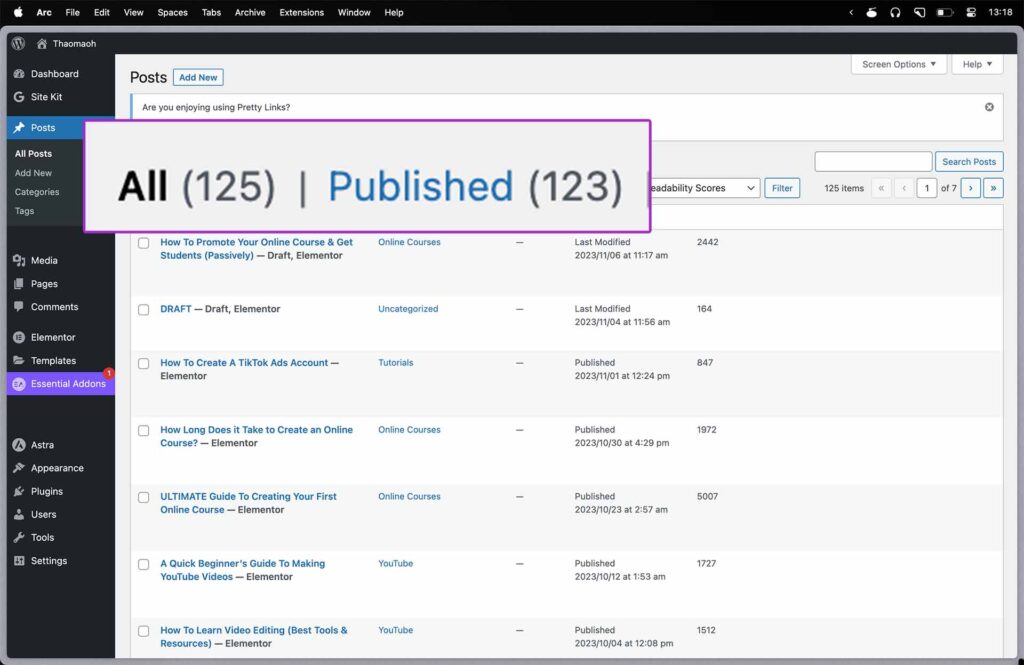
The goal is to be as helpful with your articles as possible.
Provide as much value as you can.
This will not only make your readers trust you more but also make them more likely to purchase something from you, since if the free stuff you put out there is this good, your paid stuff must be insane.
Your blog posts will then rank on Google (a blog post typically takes 8-10 months to fully rank on Google once it’s written) which means that they’ll appear in Google search results once someone types in a search phrase related to your blog post.
And that’s the best part.
Once an article ranks high on Google search results it tends to stay there for a while.
This means that people will come and read your blog posts every single day (and of course, see that you mention your course inside of them) without you having to do any more work.
This is the most passive way to promote your course.
A blog post can get visitors even 5 or 10 years after it’s been written.
What will you need?
To start a WordPress blog you’ll need hosting and a domain name (and of course a few YouTube tutorials on how to actually set up the website and start writing).
My recommendation here is Hostinger. You’ll get cheap hosting and domain there as well as be able to easily set up your WordPress website (it’s what I use for this blog as well).
I recommend checking out my Hostinger review here.
4. Add testimonials
People buy if their perceived likelihood of achievement is high.
If you can make someone with a painful problem 100% believe that once they take your course that problem will go away, they will buy.
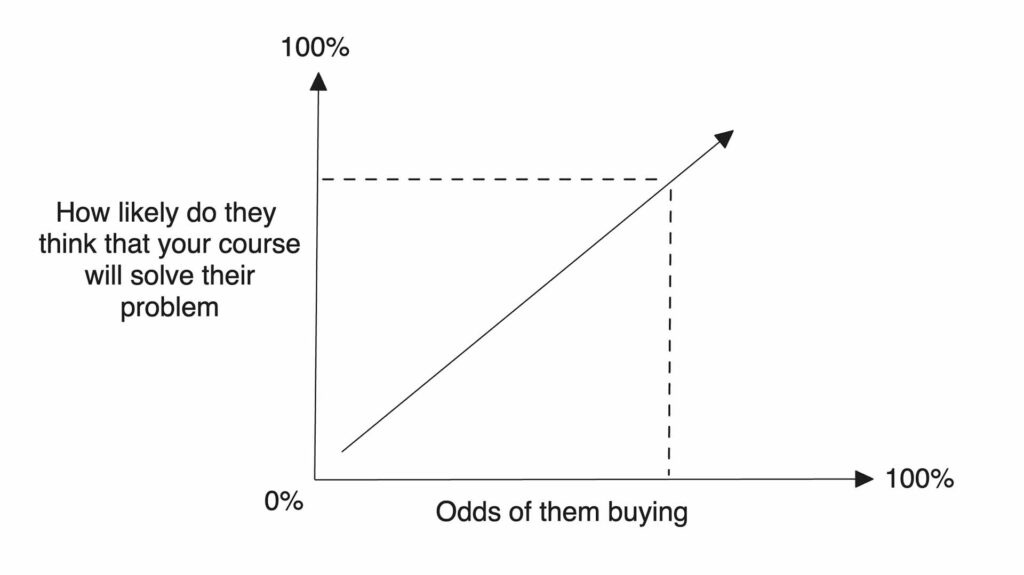
Of course, in the real world that’s hardly possible.
But we can increase someone’s perceived likelihood of achievement from taking our course by using testimonials.
Testimonials are written or filmed statements from people who can describe what it’s like to work with you, use your product, or experience the service you offer.
We can simplify it and say that a testimonial is when someone leaves a “review” once they take your course. It can be a written review or in video form (these are the best).
Most course platforms (such as Udemy or Skillshare) already have a review feature built in. And once students take your course they’re offered to leave a review.
Those reviews then show up when someone looks at your course’s landing page.
But if you put your online course on platforms without a built-in audience, such as Podia, you’ll have to craft your course landing page yourself (templates make it easier of course).
In this case, you can add customer testimonials manually yourself to help communicate to other potential students about the value you provide in your course.
Good testimonials are one of the best ways to market your online course to students who are already visiting your course page.
Testimonials build trust. They increase the perception of new students that they’ll succeed after taking your course if someone else already did before them. This makes them more likely to buy. “If so many people succeeded by taking this course, why shouldn’t I?”.
But what if you don’t have any testimonials?
- If you haven’t launched your course yet, you can offer the “test” version of it for free in return for testimonials.
- If you’ve already launched your course, you can offer it at a steep discount in return for honest testimonials.
- Create a bonus lesson or resource that only unlocks once someone leaves a testimonial or review.
Once students complete your course, make sure to ask them for feedback either via email or via a simple survey form that can be integrated into your course as one of the final lessons.
Platforms such as Podia allow you to drag and drop a “testimonials” template directly to your course landing page so including them is super easy.
Also, make sure to ask for permission from students whose testimonials you’re planning to display on your course page.
5. Set up an affiliate program for your course
It’s no secret that some of the best customers come from referrals.
So why not incentivise your course students to refer their friends to your course?
Sometimes, setting up an affiliate program might be difficult depending on the course platform that you use. But for example, a platform like Podia has this feature already integrated and allows you to set one up in just a few clicks.
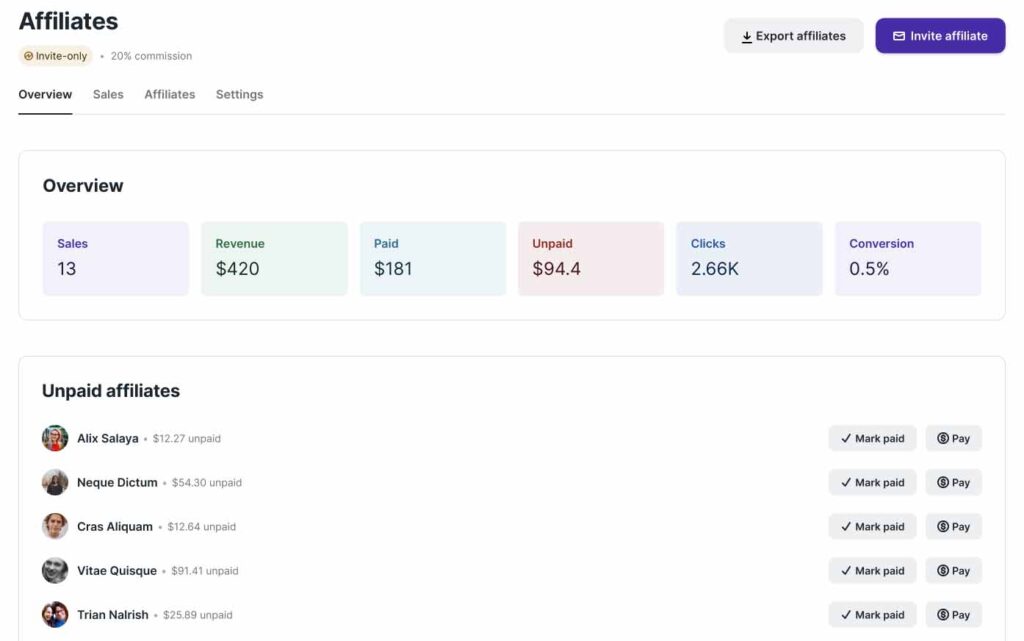
How does a course affiliate program work?
- Your course students will get a custom referral link to send to their friends.
- Once their friend purchases your course, they’ll get a commission for it (for example $50) and their friend will get a discount for your course (you can set up the discount percentage and the commission amount yourself, but be generous here). It’s a win-win-win situation.
- If the friend likes the course too he or she will share it with their friends that struggle with a similar problem.
When a friend tells you about a product they recently bought and how it changed their life it’s so much more convincing than hearing how that product will change your life in an advertisement or a YouTube video.
Moreover, people who get referred already have the best testimonial in their mind – from a close friend they know and trust.
Thus making it a lot more likely that they’ll buy your course too.
Setting up a course affiliate program is just a no-brainer thing to do because (1) it will bring you more enrolments (2) it will cost less for the people who got referred and (3) you’ll have a way of rewarding your already enrolled students with a commission making them even more satisfied with their experience of purchasing your course.
6. Offer your course in more languages
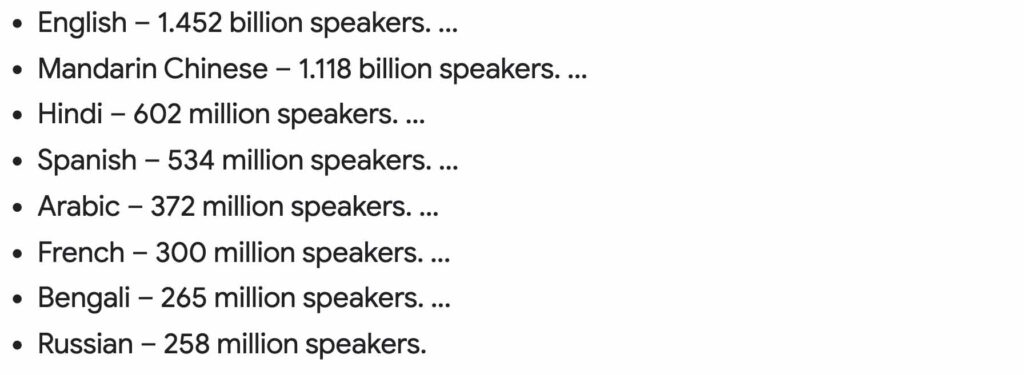
Only about 360 million people speak English as their first language. (Source: Babbel.com).
A lot more people understand English but not enough to buy a course in English.
Moreover, most courses are offered in English.
That’s why making your course in other popular languages can be such a massive opportunity to tap into. It’s an unsaturated market.
Your course doesn’t even have to be a top-notch bestseller because the competition just isn’t there.
The caveat here is that if you don’t speak more than one language fluently this will cost some money to do.
Here’s how to translate your online course to a different language:
- Hire a freelancer on Upwork.com to translate your course. If you wrote a full script for your course then you can throw it into a good translator such as Deepl.com and have a native-speaking freelancer check it for mistakes (which will cost less than for them to fully translate it from a video recording).
- Hire a voice-over artist to read out the full transcript of your course in the new language.
- Hire a video editor to put the newly recorded voice-over for your course onto your course footage and match it to what you’re saying in English.
Was this guide on how to market your online course useful?
And there you have it. I hope that this article helped you discover the ways of marketing your online course passively.
Thanks for reading 👋.
P.S. I’ll leave you with a few more killer resources that will help you with creating and perfecting your online course and bringing your students the best possible experience: